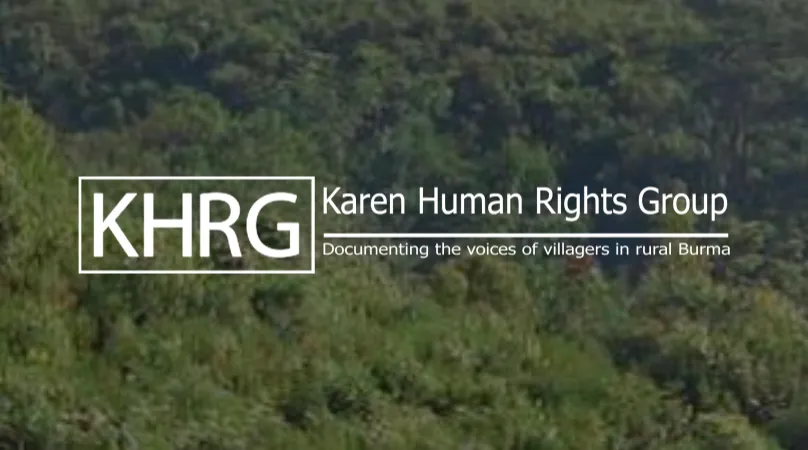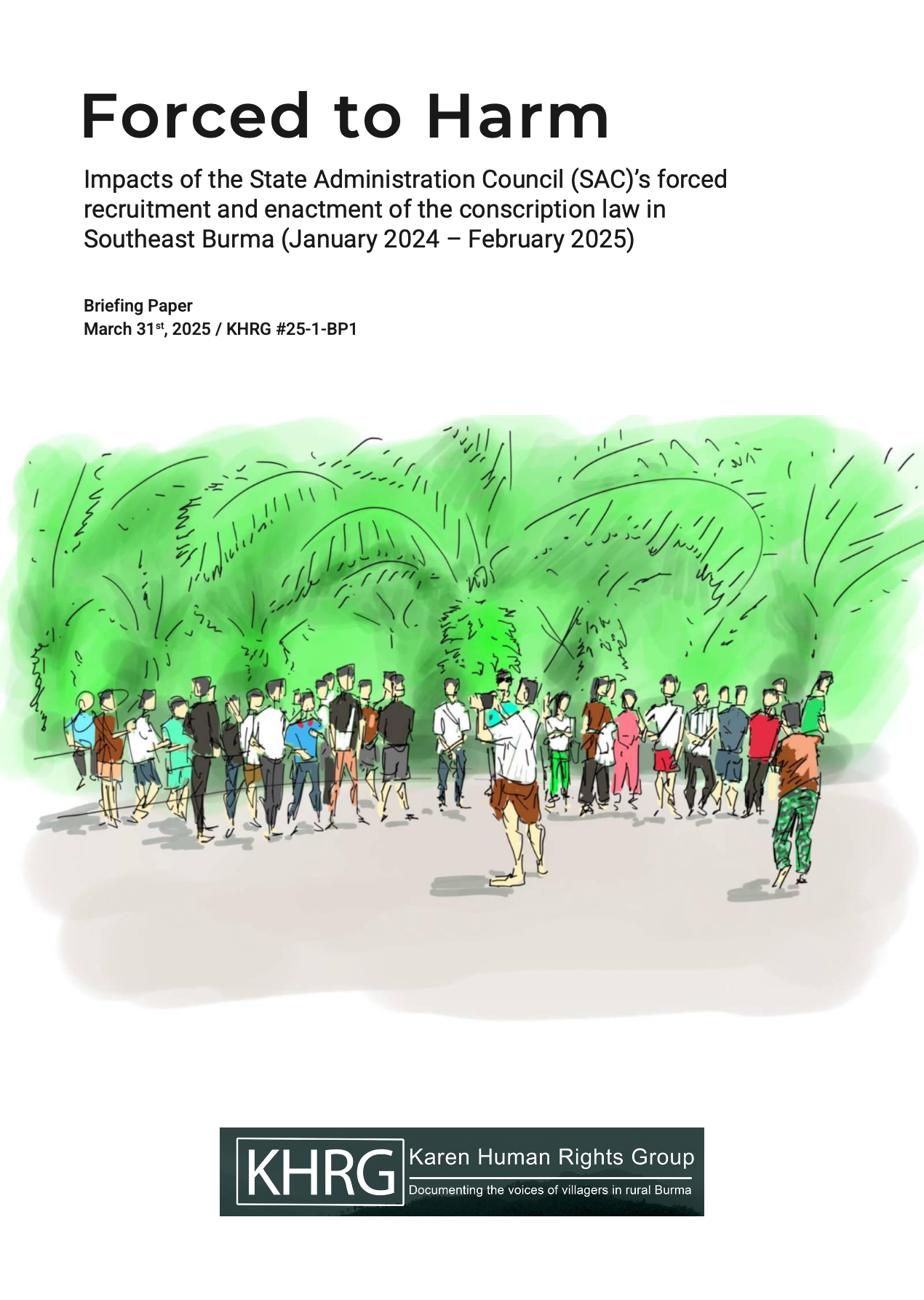Forced to Harm: Impacts of the State Administration Council (SAC)’s forced recruitment and enactment of the conscription law in Southeast Burma (January 2024 – February 2025)
31 March 2025


Introduction
Since the February 2021 coup[1], armed conflict between the State Administration Council (SAC)[2] and armed resistance groups has escalated in Southeast Burma/Myanmar.[3] The SAC has attempted to forcibly recruit civilians into their ranks at an increasing rate, from both towns and rural areas, including by announcing the enactment of the People’s Military Service Law in February 2024. Such attempts have resulted in the displacement of many young people trying to avoid conscription. The Burma Army[4] has committed numerous human rights violations for decades against the people of Southeast Burma, reinvigorated since the 2021 coup, resulting in villagers being deeply distressed at the prospect of being forced to commit similar atrocities against their own friends, families and fellow villagers, if conscripted. In 2024, the SAC targeted and forcibly recruited villagers in Southeast Burma through violent means, including arbitrary arrests, explicit threats, enforced disappearances, and physical attacks, affecting the security and livelihood of villagers in Southeast Burma.
This briefing paper presents the impacts and challenges faced by villagers in locally-defined Karen State[5] posed by the SAC’s forced recruitment, including the enactment of a conscription law, since January 2024 until February 2025. The first section provides a brief overview of the context of the human rights situation in Southeast Burma and Burma’s conscription law(s). Secondly, it presents evidence of SAC tactics used to forcibly recruit villagers, the impacts on the communities, and the challenges that villagers have faced, including SAC retaliation for refusal to follow conscription orders, villagers’ displacement to avoid conscription, and severe effects to villagers’ livelihoods and mental health. Thirdly, the briefing paper includes a security and legal analysis of the situation as well as a set of policy recommendations for local and international stakeholders.
2. Contextual overview: abuses in Southeast Burma and forced recruitment
Background of the conflict in Southeast Burma
Since Burma’s independence in 1948, the Burma Army has repeatedly violated villagers’ human rights by abusing and oppressing civilians in Southeast Burma.[6] The Karen National Liberation Army (KNLA), the armed wing of the Karen National Union (KNU)[7], and other local resistance armed groups have been engaged in armed conflict with the Burma Army since 1949. The four-cuts strategy[8] was first utilised by the Burma Army in the 1950s and 1960s to cut off ethnic armed groups from villager support, and its implementation involved the burning of villages, destruction of food, medical supplies, and other property, and the forced relocation of villagers, in clear violation of international human rights and humanitarian laws. The Burma Army’s counter-insurgency strategies in Karen State, which lasted from the mid-1970s until the mid-2000s, involved attacks on civilians, arbitrary arrests, forced labour (including forcing villagers to act as minesweepers and human shields), forced relocation, along with extrajudicial killings and torture, amounting to war crimes and crimes against humanity.[9] A preliminary ceasefire was implemented in 2012, and again in 2015, however, villagers in Southeast Burma still reported facing many abuses such as extrajudicial killings and torture.[10]
In February 2021, the Burma Army staged another coup d’état, denying the results of the democratic elections of December 2020, and proclaiming itself the State Administration Council (SAC). Since then, the SAC has reinvigorated its four-cuts strategy by violently attacking villagers and their homes, including through the use of air strikes, mortar shelling, burning of houses, shooting and killing villagers on sight, and torturing and arbitrarily arresting them, which has resulted in mass displacement and terror in locally-defined Karen State.[11]
Forced recruitment and conscription laws in Burma
Burma’s first conscription law, the National Service Bill, was drafted in 1955, however it was never officially entered into force.[12] Despite this, an investigation conducted by the International Labour Organisation (ILO) in 1998 found evidence of “regular forced recruitment throughout Myanmar, including of minors, into the Tatmadaw and various militia groups,” without any official military service law being in place.[13] These actions were conducted in the wake of the pro-democracy movement in 1988, also known as the 8888 Uprising.[14]
The People’s Military Service Law was first introduced in November 2010 by the then-ruling State Peace and Development Council (SPDC)[15] but was not enacted at the time. The law requires all men between the ages of 18 and 35 and women between the ages of 18 and 27 to serve in the Burma Army for 24 months. The law also stipulates that the length of service for individuals with technical expertise, such as doctors or engineers, can be extended to 36 months, with the age ranges extending to 45 for men and 35 for women. Those exempt from military service include: members of a religious order (such as monks, nuns, and reverends), housewives, people with permanent disabilities, and those who are exempted by the Central Drafting Board. According to the law, students, public servants, people who fail to meet medical fitness requirements, and people taking care of their elderly parents can appeal to the Central Drafting Board to temporarily postpone their military service. Those who are found guilty of failing to follow the law can be sentenced with imprisonment for three to five years or fined, or both. The fine amount is not specified.
Announcements
21 May 2025
Open letter: Malaysia must lead ASEAN with principle, not hypocrisy, to address the Myanmar crisis

Progressive Voice is a participatory rights-based policy research and advocacy organization rooted in civil society, that maintains strong networks and relationships with grassroots organizations and community-based organizations throughout Myanmar. It acts as a bridge to the international community and international policymakers by amplifying voices from the ground, and advocating for a rights-based policy narrative.